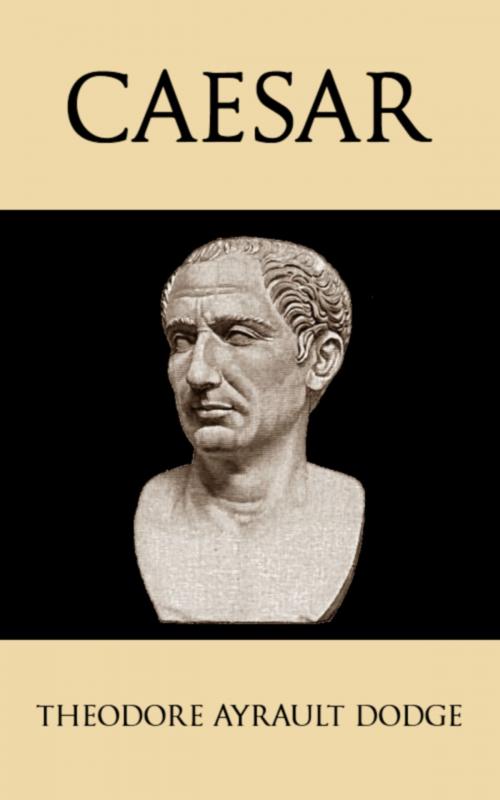Caesar
A History of the Art of War Among the Romans Down to the End of the Roman Empire, With a Detailed Account of the Campaigns of Caius Julius Caesar
Nonfiction, History, Ancient History, Rome, Military, Strategy, Biography & Memoir, Historical| Author: | Theodore Ayrault Dodge | ISBN: | 9781623580339 |
| Publisher: | Tales End Press | Publication: | August 9, 2012 |
| Imprint: | Language: | English |
| Author: | Theodore Ayrault Dodge |
| ISBN: | 9781623580339 |
| Publisher: | Tales End Press |
| Publication: | August 9, 2012 |
| Imprint: | |
| Language: | English |
At the time of his death, Julius Caesar was the most powerful man on earth. Beginning with the Gallic Wars, he had fought a series of epic campaigns, culminating in the brutal civil war that brought the Roman Republic to an end and gave birth to the new Roman Empire. His battles ranged over much of the known world, from Spain, Gaul and Italy, to Greece, Asia Minor, and Egypt. Caesar's own Commentaries are a classic account of how he led his beloved legions into battle, but they leave many questions of war and strategy unanswered.
Theodore Ayrault Dodge's illustrated history of Caesar was first published in 1892, as part of his “Great Captains” series. The author, an experienced military officer and historian, visited all of the major battlefields, and made full use of ancient sources. His history follows Caesar’s entire career, reconstructs his victories and defeats, and explains his lasting impact on the art of war. “Caesar” is an unparalleled military history of one of the world’s greatest generals. This ebook edition includes an active table of contents, reflowable text, and over 250 campaign maps, battle diagrams, and other illustrations.
Table of Contents:
• I. Marius and the Army Changes. 110–86 B.C.
• II. Sulla, Pompey. 90–60 B.C.
• III. Cæsar’s Youth, Education and Early Services. 100–58 B.C.
• IV. Cæsar’s New Province. The Helvetii. 60–58 B.C.
• V. The Battles of the Arar and Bibracte. June, 58 B.C.
• VI. Campaign against Ariovistus. August and September, 58 B.C.
• VII. The Belgæ. Spring of 57 B.C.
• VIII. Battle of the Sabis. July to September, 57 B.C.
• IX. The Work of Cæsar’s Lieutenants. 57–56 B.C.
• X. The Rhine. Spring of 55 B.C.
• XI. Britain. Fall of 55 B.C.
• XII. Cassivellaunus. Spring and Summer, 54 B.C.
• XIII. Ambiorix. Winter, 54–53 B.C.
• XIV. The Treviri and Eburones. Spring, 53 B.C.
• XV. Vercingetorix. Winter, 53–52 B.C.
• XVI. Avaricum. Late Winter and Early Spring, 52 B.C.
• XVII. The Siege of Gergovia. Spring, 52 B.C.
• XVIII. Labienus’ Campaign. Spring, 52 B.C.
• XIX. The Siege of Alesia. Summer and Fall of 52 B.C.
• XX. The Battle of Alesia. Fall of 52 B.C.
• XXI. The Bellovaci. January to April, 51 B.C.
• XXII. Uxellodunum. Spring of 51 B.C.
• XXIII. Cæsar’s Method
• XXIV. Cæsar’s Army
• XXV. Camps, Sieges and Ballistics
• XXVI. The Opening of the Civil War. December, 60, to May, 49 B.C.
• XXVII. Brundisium and Massilia. February to April, 49 B.C.
• XXVIII. Ilerda. April to June, 49 B.C.
• XXIX. Good Manœuvring. June, 49 B.C.
• XXX. Massilia, Gades, Africa. April to September, 49 B.C.
• XXXI. Epirus. November, 49, to February, 48 B.C.
• XXXII. Dyrrachium. March to May, 48 B.C.
• XXXIII. Cæsar’s Defeat. May, 48 B.C.
• XXXIV. Retreat from Dyrrachium. May, 48 B.C.
• XXXV. Pharsalus. June 29, 48 B.C.
• XXXVI. Alexandria. August, 48, to March, 47 B.C.
• XXXVII. Veni, Vidi, Vici. May and June, 47 B.C.
• XXXVIII. Ruspina. October and November, 47 B.C.
• XXXIX. Entrenched Advance. December, 47 B.C.
• XL. Ucita. January, 46 B.C.
• XLI. Thapsus. February, 47 B.C.
• XLII. Spain. December, 46, to August, 45 B.C.
• XLIII. Munda. March, 46 B.C.
• XLIV. The Man and Soldier
• XLV. Alexander, Hannibal, Cæsar
• XLVI. The Art of War of the Roman Empire
• Appendix A. Casualties in Some Ancient Battles
• Appendix B. Some Ancient Marches
• List of Dates
At the time of his death, Julius Caesar was the most powerful man on earth. Beginning with the Gallic Wars, he had fought a series of epic campaigns, culminating in the brutal civil war that brought the Roman Republic to an end and gave birth to the new Roman Empire. His battles ranged over much of the known world, from Spain, Gaul and Italy, to Greece, Asia Minor, and Egypt. Caesar's own Commentaries are a classic account of how he led his beloved legions into battle, but they leave many questions of war and strategy unanswered.
Theodore Ayrault Dodge's illustrated history of Caesar was first published in 1892, as part of his “Great Captains” series. The author, an experienced military officer and historian, visited all of the major battlefields, and made full use of ancient sources. His history follows Caesar’s entire career, reconstructs his victories and defeats, and explains his lasting impact on the art of war. “Caesar” is an unparalleled military history of one of the world’s greatest generals. This ebook edition includes an active table of contents, reflowable text, and over 250 campaign maps, battle diagrams, and other illustrations.
Table of Contents:
• I. Marius and the Army Changes. 110–86 B.C.
• II. Sulla, Pompey. 90–60 B.C.
• III. Cæsar’s Youth, Education and Early Services. 100–58 B.C.
• IV. Cæsar’s New Province. The Helvetii. 60–58 B.C.
• V. The Battles of the Arar and Bibracte. June, 58 B.C.
• VI. Campaign against Ariovistus. August and September, 58 B.C.
• VII. The Belgæ. Spring of 57 B.C.
• VIII. Battle of the Sabis. July to September, 57 B.C.
• IX. The Work of Cæsar’s Lieutenants. 57–56 B.C.
• X. The Rhine. Spring of 55 B.C.
• XI. Britain. Fall of 55 B.C.
• XII. Cassivellaunus. Spring and Summer, 54 B.C.
• XIII. Ambiorix. Winter, 54–53 B.C.
• XIV. The Treviri and Eburones. Spring, 53 B.C.
• XV. Vercingetorix. Winter, 53–52 B.C.
• XVI. Avaricum. Late Winter and Early Spring, 52 B.C.
• XVII. The Siege of Gergovia. Spring, 52 B.C.
• XVIII. Labienus’ Campaign. Spring, 52 B.C.
• XIX. The Siege of Alesia. Summer and Fall of 52 B.C.
• XX. The Battle of Alesia. Fall of 52 B.C.
• XXI. The Bellovaci. January to April, 51 B.C.
• XXII. Uxellodunum. Spring of 51 B.C.
• XXIII. Cæsar’s Method
• XXIV. Cæsar’s Army
• XXV. Camps, Sieges and Ballistics
• XXVI. The Opening of the Civil War. December, 60, to May, 49 B.C.
• XXVII. Brundisium and Massilia. February to April, 49 B.C.
• XXVIII. Ilerda. April to June, 49 B.C.
• XXIX. Good Manœuvring. June, 49 B.C.
• XXX. Massilia, Gades, Africa. April to September, 49 B.C.
• XXXI. Epirus. November, 49, to February, 48 B.C.
• XXXII. Dyrrachium. March to May, 48 B.C.
• XXXIII. Cæsar’s Defeat. May, 48 B.C.
• XXXIV. Retreat from Dyrrachium. May, 48 B.C.
• XXXV. Pharsalus. June 29, 48 B.C.
• XXXVI. Alexandria. August, 48, to March, 47 B.C.
• XXXVII. Veni, Vidi, Vici. May and June, 47 B.C.
• XXXVIII. Ruspina. October and November, 47 B.C.
• XXXIX. Entrenched Advance. December, 47 B.C.
• XL. Ucita. January, 46 B.C.
• XLI. Thapsus. February, 47 B.C.
• XLII. Spain. December, 46, to August, 45 B.C.
• XLIII. Munda. March, 46 B.C.
• XLIV. The Man and Soldier
• XLV. Alexander, Hannibal, Cæsar
• XLVI. The Art of War of the Roman Empire
• Appendix A. Casualties in Some Ancient Battles
• Appendix B. Some Ancient Marches
• List of Dates















